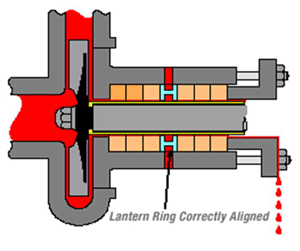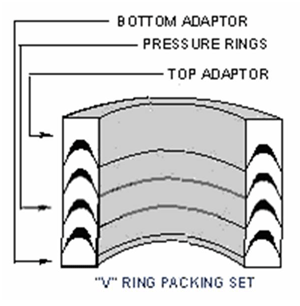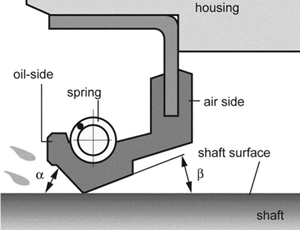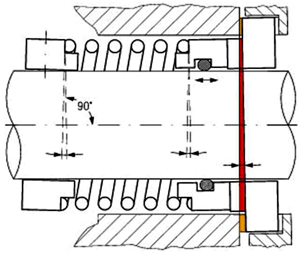Introduction
 |
| Fig. 1 Stuffing Box with packing rings. |
On any machine that has a rotating shaft there will be a shaft seal of one type or another. If the machine is a simple electric motor, for example, the seal may be used just to retain the lubricant in the bearings and to prevent dust and dirt from entering the bearing. This type of seal generally needs little or no maintenance for small motors from ¼ to perhaps 10 HP.
The shaft seals in any pump that the electric motor drives are ones that do need maintenance and replacement, whatever type of pump it is. If the pump moves liquids, such as a centrifugal water pump, it is important that the seal doesn’t leak although in some applications a small amount of leakage can be tolerated. If the liquid being pumped is hydraulic fluid, it may be at high pressure and the seal would be designed to withstand that pressure without failing.
In a vacuum pump the shaft seal has to keep the lubricating fluid in the pump and also prevent air from leaking into the pump which would affect the ultimate vacuum of the pump, and in the case of semiconductor industry pumps could cause unwanted chemical reactions with the process gases being pumped.
There are two main groups of seals, radial and axial. Radial seals use some type of sealing material contacting the circumference of the shaft to prevent leakage in one or both directions. The seal sits stationary in its housing and the shaft turns. Axial seals, also called mechanical seals and face seals, have two parts a stationary part and a rotating part. Each part contains a very smooth “face” and the two faces are held against each other by a compressed spring. One part is held in the end housing and the other part is mounted on the shaft and rotates with the shaft.
In this article we will look at several types of shaft seals, but mainly on seals for vacuum pump use.
Stuffing boxes for liquid pumps
A very early design of a shaft seal uses square section rings of “packing” in the end housing where the pump shaft extends from the pump body. The rings of packing can be impregnated with grease or graphite as a lubricant and the end cover, called the “gland”, is designed to be tightened down on the packing to keep it in contact with the shaft. (Fig. 1) The small leakage from this type of seal helps to lubricate the shaft and packing but requires regular checks to adjust the seal as the packing rings wear. The design also includes a metal “lantern ring” installed between the rings of packing to allow for lubrication or flushing. The individual rings of packing are cut from a larger roll and on installation the joints are staggered from ring to ring to eliminate any direct leak path. The pump may incorporate a drip tray or drain under the stuffing box to handle the leakage. As long as the liquid being pumped, and leaking from the seal, is not hazardous this type of seal is simple, inexpensive and still used in many industrial and marine applications.
 |
| Fig. 2 Packing set of V rings. |
V-rings, for liquids and hydraulics
A later design of the stuffing box type seal is often used in hydraulics where the square section packing ring is replaced with denser rubberized fabric V-rings. (Fig. 2) A gland is used to adjust the pressure on the rings if there is leakage. These are also used on hydraulic cylinder shafts that move axially instead of rotating and can also be used as piston seals with one set of V rings facing each way for a double-acting cylinder. Although rubberized molded fabric is the main material, these V rings can also be made of other materials such as PTFE (commonly referred to as Teflon, a DuPont trade name).
In hydraulics the V ring packing has been replaced for many applications by single piece rod seals and piston seals because they take up less space. Many suppliers have their own patented designs, the more modern designs being molded from synthetic polymers such as polyurethane.
Vacuum pump shaft seals
Radial seals
For many small and medium shaft size applications in the vacuum pump industry the mass produced “lip seal” is now the seal of choice. They are inexpensive and when installed correctly have a life of several years.
In the early days, before nitrile rubber was available, radial shaft seals were made of a leather ring held in a metal outer housing. The leather would have been grease lubricated. Most people in engineering for a few years would have heard of the company Chicago Rawhide and seen the CR logo on their products. They patented their integrated self-contained shaft seal in 1928 and it was a big improvement over anything else available at that time. Chicago Rawhide was bought by SKF in 1990 and the name and CR logo was eliminated around 2006.
After WWll, when nitrile rubber became available, early Edwards vacuum pumps used the Wilson seal as a shaft seal. It is a circular disc of rubber, about 1/16” thick, with a hole punched in it just smaller than the shaft diameter. The pump housing and seal cover plate were chamfered at about thirty degrees inwards within about a half inch of the shaft so that the rubber disc is held at that angle on the shaft surface. The edge of the punched hole forms a seal on the shaft. It was a very simple design and worked well. A bonus was that if the seal had not hardened with heat and age it could be turned over to use the other seal edge if the first edge started to leak.
 |
| Fig. 3 Radial lip seal cross-section. |
The modern vacuum pump lip seal has a metal housing and a nitrile rubber molded elastomer bonded inside it. (Fig. 3) The outer housing can be metal or can have a thin layer of rubber over the metal. It the outer housing is bare metal it should be installed with a thin layer of liquid gasket on it to prevent leaks around the housing. The rubberized housings are designed to eliminate this problem. Simple designs have a sealing edge as shown in Fig. 3 with the molded rubber edge being held onto the shaft surface by the garter spring. For certain applications PFPE and EPDM elastomers are used.
Other designs of the seal lip area are available to help lengthen the life of the seal and prevent leakage. One design incorporates a thin wavy line at the seal edge. It is only a few thousandths of an inch high but it tends to push the oil back into the pump and leaves a slightly wider wiped area of the shaft. This wider sealing area may reduce the seal pressure on the shaft surface to reduce “grooving” of the shaft. This design is unidirectional, i.e. it doesn’t matter which way the shaft rotates. Another design has angled overlapping lines molded on the sealing area which tend to push the oil back into the pump. This seal is unidirectional and has to be selected for clockwise or anti-clockwise rotation. If the wrong seal is installed it will tend to pump oil out of the seal area rather than keep the oil in the pump. Again, the slightly wider sealing area helps reduce shaft wear.
Direct drive rotary vane pumps are used with many scientific analytical instruments such as mass spectrometers and electron microscopes as well as for general laboratory vacuum applications. Because these pumps may be out of sight behind an instrument or under a fume hood, many laboratory users will place their vacuum pump in a metal collection tray to catch oil leaks. When a vacuum pump is running constantly the oil seal elastomer will slowly harden due to the heat of the pump and after two or three years may start to leak.
Most modern rotary vane direct drive oil sealed vacuum pumps have a pressurized oil circuit. If this circuit has an oil pump blade on the pump shaft it will require an inner and an outer shaft seal to prevent leakage. Servicing the outer seal is quite simple as it is usually mounted in the housing cover and can be pressed or knocked out easily and the new seal pressed in using the correct sized insertion tool and an arbor press. The inner seal can be more difficult to service. It may be difficult to access the back side of the seal from the inside of the pump body in order to knock it out. Bearing and seal removal tools are available that have expanding collets of different sizes. The lip of the expanding collet can be placed behind the seal housing and then the tool is tightened to grip and then withdraw the old seal. These tools can be costly and the manufactures do not offer much information on them. Installing the new inner seal can also be tricky as another seal insertion tool is needed and the seal must be seated squarely to work correctly. On the larger oil sealed rotary piston pumps that are frequently used on heat treating furnaces there are also removal and insertion tools needed for seals and sometimes bearings. Having the correct tools makes the seal change a lot easier.
Shaft Sleeves
 |
| Fig. 4 Axial Shaft Seal. |
Radial shaft seals exert pressure on the pump shaft due to the garter spring, and this helps with the sealing action. One downside is that this pressure can also wear a groove in the shaft after years of running. On larger pumps that tend to last twenty years or more, this will occur even on a hardened shaft. Installing a new shaft seal onto a “grooved” shaft is not recommended as it may shorten the life of the new seal. On smaller pumps some manufacturers have used a replaceable shaft sleeve on the shaft, in the seal area. This sleeve is made of hardened steel to reduce the wear, and is sealed onto the shaft with an o-ring to stop any air or oil leakage under the sleeve. One manufacturer supplies a spacer ring with a new shaft seal kit which, when installed, will move the shaft seal to a new location on the shaft. It doesn’t matter if the sleeve becomes worn as the new seal is in a new position on the shaft.
Axial or mechanical seals
This type of seal is more expensive than a lip seal, has the reputation of being more reliable and they eliminate any possibility of shaft wear. They tend to be used more on the larger sizes of vacuum pumps and also on Roots booster pumps. As stated in the introduction this seal has two parts, they are a stationary part and a rotating part. (Fig. 4) The metal stationary part is mounted in the seal cover and the sealing face is highly polished. The rotating part is mounted on the shaft and has a spring loaded sealing component, often made of carbon or graphite to give it some lubrication properties. Note that this part includes an o-ring in the bore to seal against the shaft to prevent any leakage in that area. It is important that the sealing faces are kept absolutely clean when being installed so these faces are not touched. Although the spring allows for some misalignment, both parts need to be installed squarely for a long life and correct operation. For some older Roots booster pumps in the marketplace that have lip seals, there are conversion kits available to upgrade them to have mechanical seals.
Conclusion
Shaft seals may appear to be simple components but a lot of engineering design has gone into them to make them perform well for many years. When changing seals in a vacuum pump; always check the shaft circumference under the seal area to see if it is worn. If you can feel the wear with your finger nail it indicates that the shaft should be polished, refinished or replaced.
Most oil sealed rotary vane pumps that are in use are made in Europe and will have shaft seals made to metric dimensions. A popular vee-belt drive vacuum pump, often used as a “holding pump” in the foreline is a US made pump and has inch dimensions. Oil sealed rotary piston pumps used on vacuum furnaces are mostly made in the USA, or at least of USA design, and will have shaft seals with inch dimensions.
Seals need to be installed squarely in the housings for correct operation and using tools of the right size will make the seal change easier.
Copyright Howard Tring, Tring Enterprises LLC Vacuum & Low-Pressure Consulting.
